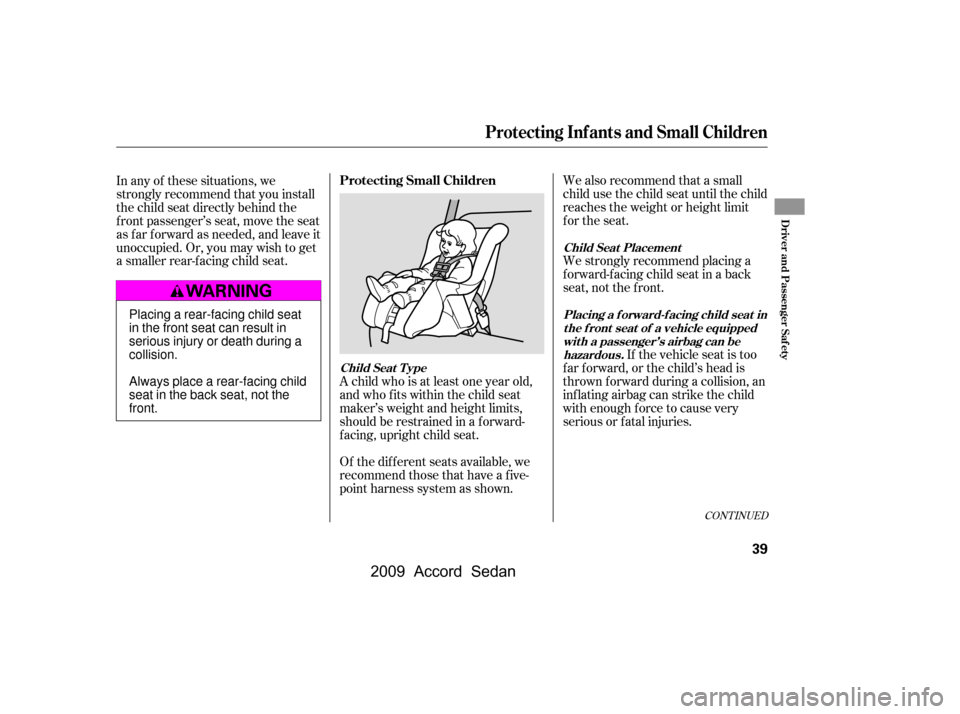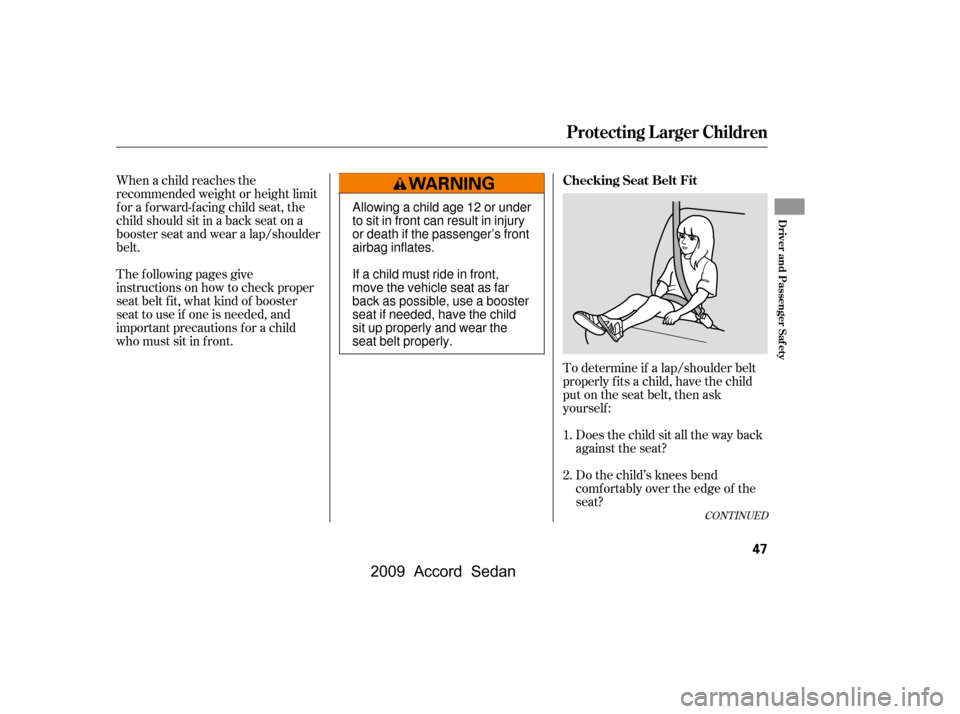Page 34 of 420

Together, airbags and
seat belts provide the best
protection.
Tampering could cause
the airbags to deploy, possibly
causing very serious injury.
If water or
another liquid soaks into a seat-
back, it can prevent the side airbag
cutof f system f rom working
properly.
Take your vehicle to an
authorized dealer as soon as
possible. If you ignore this
indication, your airbags may not
operate properly.
Even if your
airbags do not inflate, your dealer
should inspect the driver’s seat
position sensor, the f ront
passenger’s weight sensors, the
f ront seat belt tensioners, and all
seat belts and their anchors worn
during a crash to make sure they
are operating properly.
Your airbag systems are virtually
maintenance f ree, and there are no
parts you can saf ely service.
However, you must have your
vehicle serviced if:
Any airbag
that has deployed must be
replaced along with the control
unit and other related parts. Any
seat belt tensioner that activates
must also be replaced.
Do not try to remove or replace
anyairbagbyyourself.Thismust
be done by an authorized dealer or
a knowledgeable body shop.
CONT INUED
Additional Inf ormation About Your Airbags
Additional Saf ety Precautions
Airbag Service
Donotattempttodeactivateyour
airbags.
Do not t amper wit h airbagcomponent s or wiring f or anyreason.
Do not expose the f ront passenger’sseat-back to liquid.
T he SRS indicat or alert s you t o a
problem.
If your vehicle has a moderat e t osevere impact .
An airbag ever inf lates.
Driver and Passenger Saf ety
31
�\f���—�\f���—�\f���y�
����
����\f�
�y���
�)���\f���
�\f�y�\f�\f�����y
2009 Accord Sedan
Page 35 of 420
Improperly replacing
or covering f ront seat-back covers
can prevent your side airbags f rom
inf lating during a side impact.
This could make the
driver’s seat position sensor or the
f ront passenger’s weight sensors
inef f ective. If it is necessary to
remove or modif y a f ront seat to
accommodate a person with
disabilities, f irst contact Honda
Automobile Customer Service at
(800) 999-1009.
Additional Inf ormation About Your Airbags
Do not cover or replace f ront seat -
back covers wit hout consult ingyour dealer.
Do not remove or modif y a f rontseat without consulting yourdealer.
32
�\f���—�\f���—�\f���y�
����
����\f���y���
�)���\f���
�\f�y�\f�\f�����y
2009 Accord Sedan
Page 37 of 420

�µ
Front airbags have been designed to
help protect adults in a moderate to
severe f rontal collision. To do this,
the passenger’s f ront airbag is quite
large, and it can inflate with enough
f orce to cause very serious injuries.If the vehicle seat is
too far forward, or the child’s head is
thrown f orward during a collision, an
inflating front airbag can strike the
child with enough f orce to kill or
very seriously injure a small child.
Whenever possible,
larger children should sit in the back
seat, on a booster seat if needed, and
be properly restrained with a seat
belt (see page f or important
inf ormation about protecting larger
children).
According to accident statistics,
children of all ages and sizes are
saf er when they are restrained in a
back seat.
Children who ride in back are less
likely to be injured by striking
interior vehicle parts during a
collision or hard braking. Also,
children cannot be injured by an
inflating front airbag when they ride
in the back.
The National Highway Traffic Safety
Administration and Transport
Canada recommend that all children
aged 12 and under be properly
restrained in a back seat. Some
states have laws restricting where
children may ride.
Even though your vehicle has an
advanced front airbag system that
automatically turns the passenger’s
f ront airbag of f (see page ),
please f ollow these guidelines:
If
the airbag inf lates, it can hit the back
of the child seat with enough force
to kill or very seriously injure an
inf ant. 47
30
Small Children
Placing a f orward-f acing child seat inthe f ront seat of a vehicle equippedwit h a passenger’s f ront airbag canbe hazardous.
Larger ChildrenChildren who have outgrown childseat s are also at risk of being injuredor killed by an inf lat ing passenger’sfront airbag.
Inf ant s
Never put a rear-f acing child seat inthe f ront seat of a vehicle equippedwit h a passenger’s f ront airbag.All Children Should Sit in a Back
Seat The Passenger’s Front Airbag
Can Pose Serious Risks
Protecting Children General Guidelines
34
�\f���—�\f���—�\f���y�
����
��������y���
�)���\f���
�\f�y�\f�\f�����y
2009 Accord Sedan
Page 38 of 420
�µ
To remind you of the passenger’s
f ront airbag hazards, and that
children must be properly restrained
in a back seat, your vehicle has
warninglabelsonthedashboard
(U.S. models) and on the f ront visors.
Please read and follow the
instructions on these labels.U.S. ModelsCanadian Models
Protecting Children General Guidelines
Driver and Passenger Saf ety
35
DASHBOARD
SUN VISORS
SUN VISORS
�\f���—�\f���—�\f���y�
����
��������y���
�)���\f���
�\f�y�\f�\f���\f�y
2009 Accord Sedan
Page 41 of 420

A rear-f acing child seat can be placed
in any seating position in the back
seat, but not in the f ront.
If the passenger’s front airbag
inflates, it can hit the back of the
child seat with enough f orce to kill or
seriously injure an inf ant.
When properly installed, a rear-
f acing child seat may prevent the
driver or a f ront passenger f rom
moving their seat as far back as
recommended, or f rom locking their
seat-back in the desired position.
It could also interf ere with proper
operation of the passenger’s
advanced front airbag system.
Two types of seats may be used: a
seat designed exclusively f or inf ants,
or a convertible seat used in the rear-
f acing, reclining mode.
If placed
f acing f orward, an inf ant could be
very seriously injured during a
f rontal collision.
Only a rear-f acing child seat provides
proper support f or a baby’s head,
neck, and back.
An inf ant must be properly
restrained in a rear-f acing, reclining
child seat until the child reaches the
seat maker’s weight or height limit
f or the seat, and the child is at least
one year old.
Protecting Inf ants and Small Children
Never put a
rear-f acing child seat in t he f ront seat .
Do not put a rear-f acing child seat in
a f orward-f acing position.
Child Seat T ype Rear-f acing Child Seat Placement
Protecting Inf ants
38
�\f���—�\f���—�\f���y�
����
����\f���y���
�)���\f���
�\f�y�\f�\f�����y
2009 Accord Sedan
Page 42 of 420

CONT INUED
If the vehicle seat is too
f ar f orward, or the child’s head is
thrown f orward during a collision, an
inf lating airbag can strike the child
with enough force to cause very
serious or fatal injuries.
We strongly recommend placing a
forward-facing child seat in a back
seat, not the f ront.
We also recommend that a small
child use the child seat until the child
reaches the weight or height limit
for the seat.
Of the different seats available, we
recommend those that have a f ive-
point harness system as shown.
In any of these situations, we
strongly recommend that you install
the child seat directly behind the
f ront passenger’s seat, move the seat
as far forward as needed, and leave it
unoccupied. Or, you may wish to get
a smaller rear-f acing child seat.
A child who is at least one year old,
and who fits within the child seat
maker’s weight and height limits,
should be restrained in a f orward-
f acing, upright child seat.
Protecting Inf ants and Small Children
Placing a f orward-f acing child seat inthe f ront seat of a vehicle equippedwith a passenger’s airbag can behazardous.
Child Seat Placement
Child Seat T ype
Protecting Small Children
Driver and Passenger Saf ety
39
Placing a rear-facing child seat
in the front seat can result in
serious injury or death during a
collision.
Always place a rear-facing child
seat in the back seat, not the
front.
�\f���—�\f���—�\f���y�
����
����
���y���
�)���\f���
�\f�y�\f�\f�����y
2009 Accord Sedan
Page 43 of 420

Since LATCH-compatible child seats
are easier to install and reduce the
possibility of improper installation,
we recommend selecting this style.In seating positions and vehicles not
equipped with LATCH, a LATCH-
compatible child seat can be installed
using a seat belt.
Whatever type of seat you choose, to
provide proper protection, a child
seat should meet three
requirements:
Look f or FMVSS
213 or CMVSS 213 on the box.
Rear-facing for infants, forward-
f acing f or small children.
When buying a child seat, you need
to choose either a conventional child
seat, or one designed f or use with
the lower anchors and tethers for
children (LATCH) system.
Conventional child seats must be
secured to a vehicle with a seat belt,
whereas LATCH-compatible seats
are secured by attaching the seat to
hardware built into the two outer
seating positions in the back seat.
If it is necessary to put a f orward-
f acing child seat in the f ront, move
the vehicle seat as far to the rear as
possible, and be sure the child seat is
f irmly secured to the vehicle and the
child is properly strapped in the seat.
Even with advanced front airbags
that automatically turn the
passenger’s front airbag off (see
page ), a back seat is the saf est
place f or a small child.
30 Selecting a Child Seat
T he child seat should meet U.S. or
Canadian Mot or Vehicle Saf et ySt andard 213.
T he child seat should be of theproper type and size to f it the child.
1.
2.
Protecting Inf ants and Small Children, Selecting a Child Seat
40
Placing a forward-facing child
seat in the front seat can result
in serious injury or death if the
front airbag inflates.
Ifyoumustplaceaforward-
facing child seat in front, move
the vehicle seat as far back as
possible, and properly restrain
the child.
�\f���—�\f���—�\f���y�
����
������
�y���
�)���\f���
�\f�y�\f�\f�����y
2009 Accord Sedan
Page 50 of 420

To determine if a lap/shoulder belt
properly f its a child, have the child
put on the seat belt, then ask
yourself :
When a child reaches the
recommended weight or height limit
for a forward-facing child seat, the
child should sit in a back seat on a
booster seat and wear a lap/shoulder
belt.
Does the child sit all the way back
against the seat?
Do the child’s knees bend
comf ortably over the edge of the
seat?
The f ollowing pages give
instructions on how to check proper
seat belt f it, what kind of booster
seat to use if one is needed, and
important precautions f or a child
who must sit in f ront.
1.
2.
CONT INUED
Protecting L arger Children
Checking Seat Belt Fit
Driver and Passenger Saf ety
47
Allowing a child age 12 or under
to sit in front can result in injury
or death if the passenger’s front
airbag inflates.
If a child must ride in front,
move the vehicle seat as far
back as possible, use a booster
seat if needed, have the child
sit up properly and wear the
seat belt properly.
�����—�����—�����y�
����
����
���y���
�)�������
���y���������y
2009 Accord Sedan